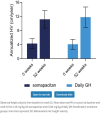Long acting growth hormone (LAGH), an update
- PMID: 37842029
- PMCID: PMC10569466
- DOI: 10.3389/fped.2023.1254231
Long acting growth hormone (LAGH), an update
Abstract
In 1957, Maurice Raben at Yale was able to isolate and purify growth hormone from cadaveric pituitary glands. Pituitary growth hormone was the only way to treat children with growth hormone (GH) deficiency, until 1985 when recombinant GH became available for daily subcutaneous injection. For many years, the pediatric endocrine community longed for a long-acting recombinant GH formulation that would decrease the inconvenience of daily injections. Several mechanisms were employed to develop a GH that is rapidly absorbed into the blood stream after subcutaneous injection, but provides slow removal from the circulatory system to potentially optimize patient adherence to GH therapy. Four long-acting growth hormones are currently available in the world, or are close to regulatory approval. They are: (1) Pegylated formulations, (2) Prodrug formulations which are converted into active drug, (3) Nonvalent transient albumin binding GH compounds and (4) GH fusion proteins where a protein si fused with GH. All four formulations have undergone detailed phase 3 studies and were found to show non-inferiority in these clinical studies. All four demonstrate a safety and tolerability profile that is comparable to that of daily somatropin with an excellent adherence profile.
Keywords: fusion proteins; growth hormone; growth hormone deficiency; long acting growth hormone; pegylation.
© 2023 Grillo, Frank and Saenger.
Conflict of interest statement
The authors declare that the research was conducted in the absence of any commercial or financial relationships that could be construed as a potential conflict of interest.
Figures



References
-
- Mejia-Corletto J, Saenger PH. Long-acting growth hormone: an update. In: Cappa M, Cianferani S, Ghizzoni L, Lockhe S, Maghnie M, editors. Advanced therapies in pediatric endocrinology and diabetology. Vol. 30. Endocrin Dev, Basel Karger; (2016). p. 79–97. - PubMed
Publication types
LinkOut - more resources
Full Text Sources

